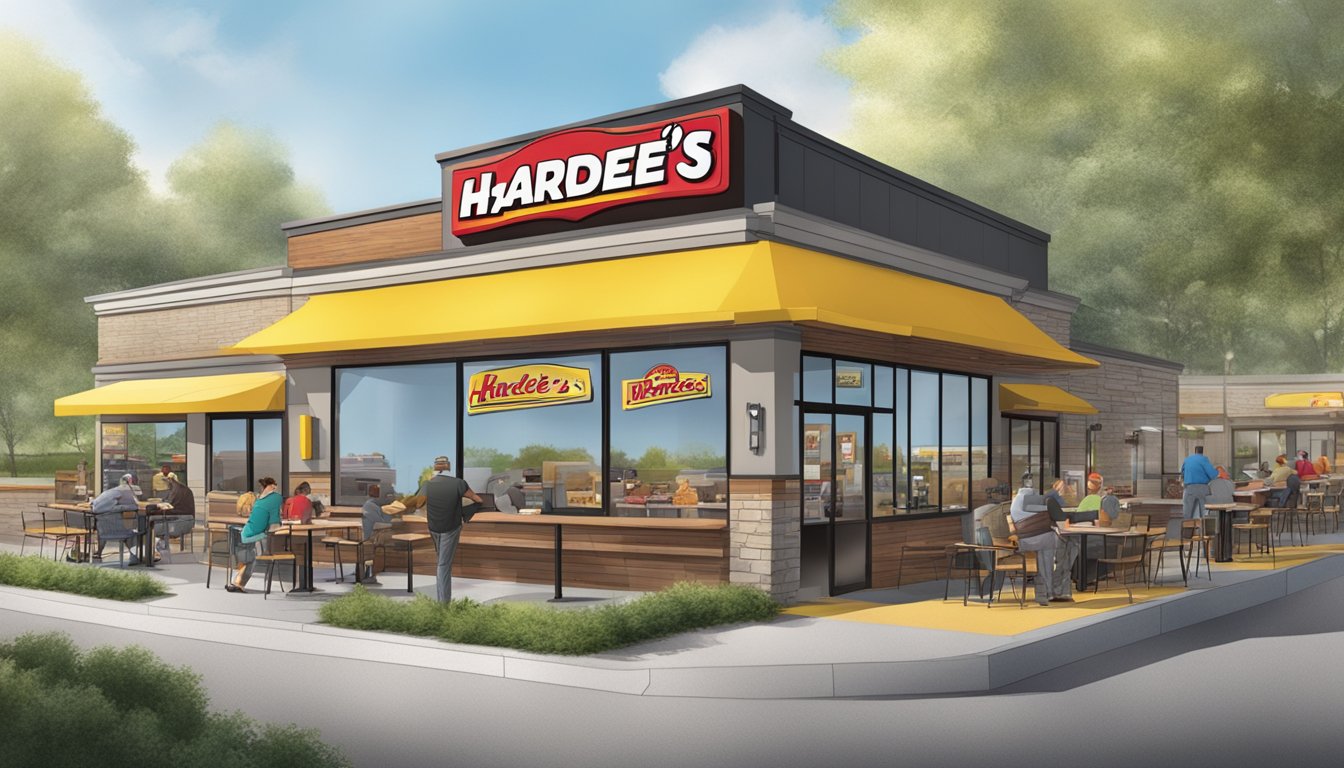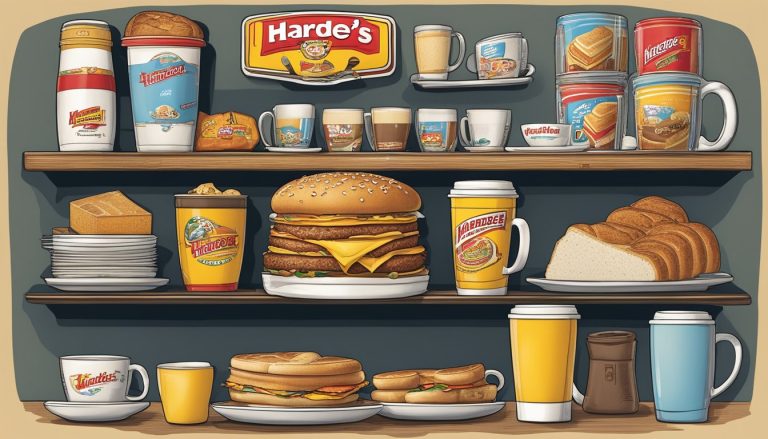Hardee’s, a prominent player in the quick-service restaurant industry, has built a strong reputation for its breakfast offerings. Founded in 1960 in Greenville, North Carolina, the chain has expanded to hundreds of locations across the United States and internationally.
The Hardee’s breakfast franchise model presents a compelling business opportunity for entrepreneurs seeking to enter the fast food market. With a focus on hearty breakfast items and a loyal customer base, Hardee’s franchisees can tap into a profitable segment of the restaurant industry.
Analyzing the Hardee’s breakfast franchise model reveals a well-established system backed by decades of experience. The company provides comprehensive support to franchisees, including market research assistance, staff training programs, and marketing strategies. This robust support structure, combined with Hardee’s recognizable brand and popular breakfast menu, positions franchisees for potential success in the competitive fast food landscape.
Understanding Franchising Concepts

Franchising is a business model that allows entrepreneurs to operate under an established brand name. It involves a contractual relationship between a franchisor and franchisee, with specific rights and obligations for both parties.
What Is a Franchise?
A franchise is a licensed business arrangement where the owner (franchisor) grants another party (franchisee) the right to use their trademark, business model, and systems. The franchisee pays fees and royalties in exchange for this right.
Franchises operate across various industries, from fast food to retail and services. The franchisee receives training, support, and a proven business format from the franchisor.
This model allows rapid expansion for the franchisor while providing a lower-risk entry into business ownership for the franchisee.
Franchise System Overview
The franchise system consists of several key components:
- Trademark: The brand name and logo used by all franchisees
- Operating system: Standardized processes and procedures
- Support structure: Training, marketing, and ongoing assistance
- Financial arrangement: Initial fees, royalties, and other costs
Franchisors provide detailed operations manuals and guidelines to ensure consistency across locations. Franchisees must adhere to these standards to maintain brand integrity.
Regular inspections and performance evaluations are common in franchise systems to uphold quality standards.
Benefits of Franchising
Franchising offers advantages for both franchisors and franchisees:
For franchisors:
- Rapid business expansion
- Increased brand recognition
- Additional revenue streams through fees and royalties
For franchisees:
- Established brand and customer base
- Proven business model and systems
- Marketing and operational support
- Lower risk compared to starting an independent business
Franchising allows for economies of scale in purchasing and advertising. It also provides a network of fellow franchisees for support and shared knowledge.
However, franchisees must balance the benefits with reduced autonomy and ongoing financial obligations to the franchisor.
Hardee’s Franchise Model

Hardee’s has developed a robust franchise model that has fueled its growth and success in the quick service restaurant industry. The company offers multiple franchise formats and strategic partnerships to expand its market presence.
History and Growth of Hardee’s
Hardee’s was founded in 1960 in Greenville, North Carolina. The first location was a small walk-up restaurant with a simple menu of hamburgers and milkshakes. By the late 1960s, Hardee’s had expanded to nearly 200 locations.
The company’s growth accelerated through franchising. Today, about 95% of Hardee’s 2,200 units are owned by franchisees. This high percentage demonstrates the success and appeal of the Hardee’s franchise model.
Hardee’s expansion strategy includes offering three franchise formats: standalone Hardee’s restaurants, Dual Concept locations, and Co-Brand units. This flexibility allows franchisees to choose the best option for their market and business goals.
Hardee’s Position in the Quick Service Restaurant Sector
Hardee’s has established a strong position in the competitive quick service restaurant sector. The brand is known for its charbroiled burgers, breakfast items, and signature biscuits.
Key factors contributing to Hardee’s success include:
- Unique menu offerings
- Focus on quality ingredients
- Strong operational support for franchisees
- Robust marketing strategies
Hardee’s franchising model provides comprehensive support to its partners. This includes assistance with:
- Market research
- Business planning
- Financial modeling
- Site selection
- Staff training
- Marketing initiatives
These support systems help franchisees launch and operate successful Hardee’s locations.
Dual Concept with Carl’s Jr
Hardee’s operates a dual concept model with Carl’s Jr, another well-known quick service restaurant brand. This partnership has expanded the reach and appeal of both brands.
Key aspects of the dual concept model:
- Shared menu items and branding elements
- Regional focus: Hardee’s primarily in the Southeast and Midwest, Carl’s Jr in the West
- Unified franchise system allowing for easier expansion
The dual concept approach allows franchisees to leverage the strengths of both brands. It also provides opportunities for menu innovation and cross-regional expansion.
This strategic partnership has helped Hardee’s maintain its competitive edge in the fast food industry. It offers franchisees increased flexibility and potential for growth in diverse markets.
Initial Steps to Franchise Ownership

Prospective Hardee’s franchisees must navigate several crucial steps before launching their business. These include reviewing the Franchise Disclosure Document, understanding the initial franchise fee, and estimating the total investment required.
Introduction to Hardee’s Franchise Disclosure Document (FDD)
The Franchise Disclosure Document (FDD) is a comprehensive legal document that outlines the terms and conditions of the Hardee’s franchise agreement. It provides essential information about the franchisor, franchise system, and financial requirements.
Key sections of the FDD include:
- Franchisor’s background and business experience
- Litigation history
- Bankruptcy disclosures
- Initial fees and ongoing costs
- Obligations of the franchisee and franchisor
- Territory rights and restrictions
Prospective franchisees should carefully review the FDD with a qualified attorney to fully understand their rights and responsibilities. This document forms the foundation of the franchise relationship and helps inform the decision to invest in a Hardee’s franchise.
Understanding the Initial Franchise Fee
The initial franchise fee for a Hardee’s franchise typically ranges from $25,000 to $45,000 per store. This fee grants the franchisee the right to use Hardee’s brand, trademarks, and business systems.
Factors affecting the franchise fee:
- Location of the franchise
- Size of the operation
- Number of stores being opened
The fee covers:
- Initial training for management team
- Access to proprietary systems and processes
- Use of Hardee’s brand and trademarks
Some multi-unit development agreements may offer fee discounts for additional stores. Franchisees should factor this fee into their overall investment calculations when planning their Hardee’s franchise venture.
Estimated Initial Investment
The total initial investment for a Hardee’s franchise extends beyond the franchise fee. Prospective owners must account for various startup costs to launch their restaurant successfully.
Estimated initial investment range: $1.3 million to $1.9 million
Key components of the initial investment:
- Real estate purchase or lease
- Building construction or renovation
- Kitchen equipment and furnishings
- Signage and decor
- Initial inventory and supplies
- Working capital for first 3-6 months
Factors influencing investment costs:
- Location (urban vs. rural)
- Property size and condition
- Local labor and construction costs
- Specific restaurant format (traditional vs. non-traditional)
Franchisees should create a detailed financial plan and secure adequate funding before proceeding with their Hardee’s franchise purchase. Consulting with financial advisors can help ensure a comprehensive understanding of the investment required.
Financial Investment Details

Opening a Hardee’s breakfast franchise requires substantial capital and ongoing financial commitments. Prospective franchisees must carefully evaluate the costs, fees, and potential returns before proceeding.
Breakdown of Costs and Fees
The total investment to open a Hardee’s franchise ranges from $1,303,000 to $3,436,000. This includes the initial franchise fee of $35,000.
Key costs:
- Real estate and construction: $800,000 – $2,500,000
- Equipment and signage: $300,000 – $600,000
- Initial inventory: $15,000 – $25,000
- Working capital: $125,000 – $225,000
Ongoing fees:
- Royalty: 4% of gross sales
- Advertising: Up to 5% of gross sales
These figures vary based on location, restaurant size, and local market conditions.
Assessing Funding and Financing Options
Franchisees typically need to have liquid assets of at least $500,000 and a net worth of $1,000,000 or more. Several financing options are available:
- SBA loans: Offer competitive rates and longer repayment terms
- Traditional bank loans: May require significant collateral
- Franchisor financing: Hardee’s may offer limited financing to qualified candidates
- Investor partnerships: Can help spread the financial burden
It’s crucial to consult with financial advisors and thoroughly review the Franchise Disclosure Document before committing to any funding option.
Average Revenue and Profitability Analysis
While specific revenue figures for Hardee’s breakfast franchises are not publicly disclosed, industry estimates suggest:
- Average annual sales: $1,000,000 – $1,500,000
- Profit margins: 8% – 12% of gross sales
Factors affecting profitability:
- Location and local competition
- Operating costs and labor management
- Marketing effectiveness
- Quality of customer service
Franchisees should develop a detailed business plan and financial projections based on their specific market and operational strategy. Success often depends on efficient management and strong local marketing efforts.
Operational Aspects of a Hardee’s Franchise
Running a Hardee’s franchise involves managing equipment, inventory, staff training, and creating a consistent dining experience. Franchisees receive comprehensive support to ensure smooth operations and maintain brand standards.
Key Equipment and Inventory for Operations
Hardee’s franchises require specific equipment to prepare their signature menu items. This includes grills, fryers, refrigerators, and specialized tools for making biscuits and other breakfast items. Franchisees must maintain an inventory of fresh ingredients, including meats, produce, and baked goods.
Proper storage and rotation of food items is crucial to maintain quality and safety standards. Franchisees use inventory management systems to track stock levels and place orders efficiently. Regular maintenance of kitchen equipment is essential to prevent downtime and ensure food safety compliance.
Staff Training and Operational Support
Hardee’s provides extensive training programs for franchise owners and their staff. New franchisees undergo a 10-week training program covering all aspects of restaurant operations. This includes food preparation techniques, customer service standards, and management skills.
Ongoing training is offered to keep staff up-to-date on new menu items and operational procedures. Hardee’s corporate team provides support in areas such as:
- Marketing and promotions
- Supply chain management
- Quality control
- Technology implementation
This support helps franchisees maintain consistent quality across all locations.
Creating the Hardee’s Dining Experience
Hardee’s franchises aim to provide a welcoming atmosphere for customers. This involves maintaining a clean, well-lit dining area and efficient drive-thru service. Franchisees must adhere to brand guidelines for restaurant design and layout.
Staff are trained to deliver friendly, prompt service. This includes greeting customers, taking orders accurately, and addressing any concerns. The dining experience extends to food presentation, with strict standards for how menu items should look when served.
Speed of service is a key focus, particularly during busy breakfast and lunch periods. Franchisees implement systems to monitor and improve order fulfillment times. Creating a positive dining experience helps build customer loyalty and drive repeat business.
Marketing and Customer Relations

Hardee’s breakfast franchise model relies on strategic marketing and strong customer relationships. Effective campaigns showcase menu offerings while loyalty programs and personalized service foster a dedicated customer base.
Developing Effective Marketing Plans
Hardee’s marketing plans focus on highlighting signature breakfast items like Made From Scratch Biscuits. Campaigns emphasize quality ingredients and hearty portions to differentiate from competitors. Local franchises tailor promotions to regional tastes and preferences.
Television and radio ads feature mouthwatering visuals of breakfast platters. Digital marketing leverages social media to engage younger demographics. Eye-catching in-store displays promote limited-time offers and new menu additions.
Franchisees collaborate with corporate marketing teams to align national brand messaging with local market needs. Co-op advertising funds allow franchises to pool resources for larger marketing initiatives.
Understanding and Capturing Customer Preferences
Hardee’s conducts regular market research to stay attuned to evolving breakfast trends. Customer surveys and focus groups provide insights into flavor preferences and emerging dietary needs.
Menu innovation teams use this data to develop new items that appeal to health-conscious consumers and indulgence seekers alike. Limited-time offers test potential permanent additions.
Mobile apps and loyalty programs collect valuable data on ordering patterns and preferences. This information helps franchises optimize inventory and staffing to meet demand.
Building and Retaining a Customer Base
Consistency in food quality and service is key to building customer loyalty. Franchises implement rigorous training programs to ensure staff deliver a positive dining experience.
Targeted promotions encourage repeat visits, such as buy-one-get-one deals or discounted combo meals. Birthday rewards and exclusive app-based offers incentivize customers to join loyalty programs.
Community involvement strengthens local connections. Franchises often sponsor school events or partner with charities to boost brand perception and foster goodwill.
Prompt response to customer feedback, both in-store and online, demonstrates commitment to satisfaction. Addressing concerns quickly helps convert dissatisfied customers into brand advocates.
Building Blocks for Growth

Hardee’s breakfast franchise growth relies on strategic site selection, strong partnerships, and multi-unit development. These key elements form the foundation for expanding the brand’s presence and market share.
Site Selection and Construction Requirements
Hardee’s employs rigorous criteria for selecting optimal restaurant locations. Prime spots include high-traffic areas, corner lots, and sites with good visibility. The company prefers freestanding buildings with drive-thru capabilities.
Construction requirements typically include:
- Lot size: 30,000-40,000 square feet
- Building size: 2,500-3,000 square feet
- Parking spaces: 35-45
Franchisees must adhere to Hardee’s design specifications, ensuring brand consistency. This includes exterior signage, interior decor, and kitchen layout.
Market research plays a crucial role in site selection. Demographic data, traffic patterns, and competitor analysis inform decisions to maximize potential success.
Exploring Franchise Partnerships and Agreements
Hardee’s seeks franchisees with strong business acumen and financial stability. Ideal partners possess:
- Net worth of $1,000,000+
- Liquid assets of $300,000+
- Multi-unit restaurant experience (preferred)
The franchise agreement outlines terms and conditions, including:
- Initial franchise fee
- Royalty payments
- Marketing contributions
- Territory rights
Franchisees receive support in areas such as training, operations, and marketing. The development agreement specifies the number of units to be opened within a set timeframe.
Expansion through Multi-Unit Development
Multi-unit development is a key strategy for Hardee’s growth. This approach offers benefits for both the franchisor and franchisees:
- Economies of scale
- Streamlined operations
- Faster market penetration
Franchisees can secure exclusive rights to develop multiple units in a specific territory. This allows for strategic planning and efficient resource allocation.
Hardee’s provides enhanced support for multi-unit operators, including:
- Dedicated franchise business consultants
- Customized training programs
- Assistance with local marketing initiatives
Multi-unit development agreements often include incentives such as reduced franchise fees for subsequent units.
Legal and Regulatory Considerations

Navigating the legal landscape is crucial for Hardee’s breakfast franchise owners. Understanding permits, licenses, and regulations while seeking expert guidance ensures compliance and smooth operations.
Navigating Permits, Licenses, and Regulations
Hardee’s breakfast franchise operators must obtain specific permits and licenses to operate legally. These include food service licenses, health department permits, and business licenses. Local zoning laws may also impact location selection and signage.
Franchisees must adhere to food safety regulations, including proper food handling, storage, and preparation practices. Regular inspections by health officials ensure compliance with these standards.
Employment laws, including minimum wage requirements and workplace safety regulations, apply to franchise operations. Owners must stay informed about changes in labor laws to maintain compliance.
The Role of a Franchise Consultant and Legal Advisor
A franchise consultant provides valuable insights into the Hardee’s breakfast franchise model. They help potential franchisees evaluate the opportunity and understand the franchisor’s requirements.
Legal advisors specializing in franchise law review the Franchise Disclosure Document (FDD) and Franchise Agreement. They explain legal obligations, negotiate terms, and ensure the franchisee’s interests are protected.
These experts guide franchisees through trademark usage rules, territorial rights, and renewal processes. Their expertise helps navigate complex legal issues unique to the franchise business model.
Financial Management and Analysis

Effective financial management is crucial for the success of a Hardee’s breakfast franchise. Proper analysis of key financial metrics helps franchisees make informed decisions and optimize their operations.
Assessment of Operating Expenses and Working Capital
Operating expenses for a Hardee’s breakfast franchise typically include food costs, labor, rent, utilities, and marketing. Food costs usually account for 30-35% of sales, while labor expenses range from 25-30%. Rent and utilities can vary by location but often represent 8-12% of sales.
Working capital requirements depend on factors like inventory levels, payment terms, and sales volume. Franchisees generally need 3-6 months of operating expenses as working capital. This ensures smooth operations and the ability to handle unexpected costs or fluctuations in revenue.
Efficient inventory management is key to controlling expenses. Implementing just-in-time ordering systems can help reduce waste and minimize storage costs.
Understanding Royalties and Recurring Fees
Hardee’s franchisees pay ongoing royalties and fees to the franchisor. The royalty fee is typically 4-5% of gross sales, paid weekly or monthly. This fee covers the use of the Hardee’s brand and ongoing support from the franchisor.
Additional recurring fees may include:
- Advertising fee: 3-4% of gross sales
- Technology fee: $200-$300 per month
- Training fee: $1,000-$2,000 annually
These fees contribute to national marketing campaigns, system-wide technology improvements, and ongoing training programs. Franchisees should factor these costs into their financial projections and budgeting processes.
Calculating EBITDA and Gross Sales
EBITDA (Earnings Before Interest, Taxes, Depreciation, and Amortization) is a key metric for assessing franchise profitability. For Hardee’s breakfast franchises, EBITDA margins typically range from 10-15% of gross sales.
To calculate EBITDA:
- Start with gross sales
- Subtract cost of goods sold and operating expenses
- Add back interest, taxes, depreciation, and amortization
Gross sales for a Hardee’s breakfast franchise can vary widely based on location, competition, and local market conditions. Average annual gross sales for a Hardee’s restaurant range from $1 million to $1.5 million, with top-performing locations exceeding $2 million.
Franchisees should track these metrics regularly and compare them to industry benchmarks to identify areas for improvement and growth opportunities.
Critical Success Factors

Hardee’s breakfast franchise success hinges on several key elements that drive profitability and customer satisfaction. These factors encompass menu innovation, brand leverage, and strategic financial planning.
Meeting Customer Demand for Specialty Menu Items
Hardee’s thrives on its ability to offer unique breakfast options that set it apart from competitors. Hand-breaded chicken tenders and made-from-scratch biscuits are signature items that attract loyal customers. The franchise’s success relies on consistently delivering high-quality, freshly prepared meals.
Franchisees must maintain strict quality control and efficient kitchen operations to meet demand during peak breakfast hours. Training staff to prepare specialty items quickly without compromising taste or presentation is crucial.
Menu innovation keeps customers engaged. Introducing seasonal specials or regional favorites can boost sales and differentiate individual locations. Franchisees should stay attuned to local preferences and adapt their offerings accordingly.
Leveraging Brand Strength and Recognition
Hardee’s strong brand identity plays a vital role in franchise success. The recognizable logo and reputation for hearty, satisfying meals give franchisees a competitive edge in the quick-serve restaurant market.
Effective local marketing campaigns that align with national branding efforts help reinforce customer loyalty. Franchisees benefit from corporate-level advertising but must also engage in community outreach and targeted promotions.
Social media presence and positive online reviews are increasingly important. Franchisees should actively manage their digital reputation and respond promptly to customer feedback.
Implementing Pricing Strategies and Financial Forecasting
Successful Hardee’s franchises balance competitive pricing with profitability. Pricing strategies must account for local market conditions, ingredient costs, and operational expenses.
Financial forecasting helps franchisees anticipate seasonal fluctuations and plan for long-term growth. Accurate projections of sales, costs, and profit margins are essential for making informed business decisions.
Franchisees should regularly analyze key performance indicators such as food cost percentages, labor costs, and average transaction values. This data informs menu pricing adjustments and operational improvements.
Implementing cost-saving measures without compromising quality is crucial. Efficient inventory management and strategic supplier relationships can significantly impact the bottom line.
Key Takeaways and Strategic Insights

Hardee’s franchise model relies heavily on strategic expansion and market capture techniques. The company offers three distinct franchise formats: Hardee’s, Dual Concept, and Co-Brand locations.
This flexibility allows franchisees to choose the best option for their local market conditions. It also enables Hardee’s to cater to diverse consumer needs while maintaining its core value proposition.
Approximately 95% of Hardee’s 2,200 units are operated by franchisees, demonstrating the success of this business model. This high percentage indicates strong franchisor support and attractive profit potential for franchise partners.
Hardee’s Restaurants LLC, organized in 2013, oversees the franchise operations. The company’s headquarters in St. Louis, Missouri, serves as the central hub for strategic planning and franchise support.
Key strengths of the Hardee’s franchise model:
- Established brand recognition
- Flexible franchise formats
- Strong franchisor support
- Proven business model
Franchise locations benefit from Hardee’s targeted marketing approach, which enhances customer engagement. The company also employs competitive pricing strategies to remain attractive to consumers while maintaining profitability for franchisees.
Potential franchisees should consider Hardee’s limited international presence compared to some global competitors. This factor may impact long-term growth opportunities in certain markets.




